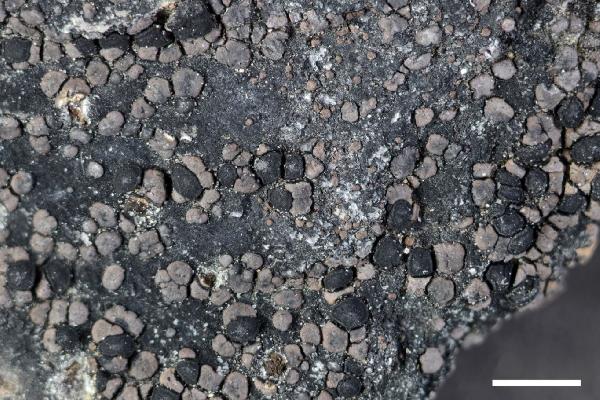Rhizocarpon vulgare Timdal, E.J. Möller & Bendiksby
Graphis Scripta, 36, 4: 101, 2024.
Synonyms:
Distribution:
Description: Thallus crustose, episubstratic, grey to grey-brown, areolate, forming up to 10 cm wide patches delimited by a black prothallus, the areoles more or less contiguous, orbicular or angular to slightly crenulate, flat to usually convex. Medulla I-, K/I-. Apothecia black, epruinose, up to 1 mm across, orbicular, with a more or less flat disc and a thin proper margin. Proper exciple blackish brown, K+ purple-red or K-; epithecium dark brown, thin, sharply delimited, without crystals and granules, K+ rather faintly purple-red; hymenium colourless; paraphysoids branched and anastomosing; hypothecium brown, K-. Asci 8-spored, clavate, fissitunicate, with a well-developed tholus that is K/I- in lower part and K/I+ blue near the apex, lacking an ocular chamber, Rhizocarpon-type. Ascospores 1-septate, soon dark brown, ellipsoid, 26-35 x 12-17 µm. Photobiont chlorococcoid. Spot tests: cortex and medulla K-, C-, KC- P-. Chemistry: medulla with diffractaic acid.Note: a recently-described species resembling Rh. badioatrum but differing in often forming more rounded, convex, and greyish areolae; in having a more narrow and more sharply delimited epithecium with a less intense K+ red reaction, and especially in containing diffractaic acid. The species seems to be widespread in Scandinavia, with several records in Central and Southern Europe, e.g. in Slovakia (Timdal & al. 2024) and France, including Corsica (Roux & Coll. 2025). It should be looked for also in Italy (specimens of Rh. badioatrum should be chemically analysed).
Growth form: Crustose
Substrata: rocks
Photobiont: green algae other than Trentepohlia
Reproductive strategy: mainly sexual

Predictive model
Growth form: Crustose
Substrata: rocks
Photobiont: green algae other than Trentepohlia
Reproductive strategy: mainly sexual

Predictive model


